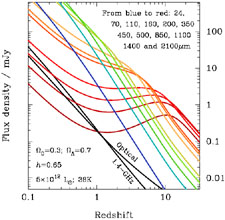


2.5. The observability of high-redshift dusty galaxies
The detectable flux density at an observed frequency
 from a galaxy with
bolometric luminosity L at redshift z with an intrinsic SED
f
from a galaxy with
bolometric luminosity L at redshift z with an intrinsic SED
f ,
,
 |
(3) |
where DL is the luminosity distance to redshift z (for example Peebles, 1993).
The key feature that makes submm-wave observations of distant
galaxies interesting is the ability to sample the SED of a
target galaxy at wavelengths for which the SED is a strongly
increasing function of frequency
(Fig. 2).
This ensures that distant
galaxies are observed at a rest-frame wavelength closer to the peak of
their SED. There is thus a strong, negative K correction, which
leads to high-redshift
galaxies being relatively easy to detect at submm wavelengths as
compared with their low-redshift counterparts. This effect is illustrated
in Fig. 4 for the template SED from
Blain et al. (1999b)
shown in Fig. 2.
The strong K-correction effect applies at wavelengths longer
than about 250 µm. At these wavelengths
the flux density from galaxies at z > 1 ceases
to decline with the inverse square of distance, but instead remains
approximately constant with increasing redshift. A window is
thus opened to the detection of all galaxies with similar SEDs at
redshifts up to z
 10-20. The effect is
more pronounced at longer wavelengths: in the mm waveband
more distant galaxies are expected to produce greater flux densities than
their more proximate counterparts.
10-20. The effect is
more pronounced at longer wavelengths: in the mm waveband
more distant galaxies are expected to produce greater flux densities than
their more proximate counterparts.
 |
Figure 4. The predicted flux density of a dusty galaxy as a function of redshift in various submm atmospheric windows, and at shorter wavelengths that will be probed by forthcoming space missions. Note the powerful K correction in the mm and submm wavebands at wavelengths longer than about 250 µm, which yields a flux density that is almost independent of redshift. The template spectrum is chosen to reproduce the typical properties of distant submm-selected galaxies (Fig. 2). Subtle effects due to the additional heating of dust by the CMB, and fine details of the radio SED of galaxies are not included; these effects are illustrated in Fig. 8. |
Note that both the radio and optical flux-density-redshift relations decline steeply with increasing redshift, and so high-redshift galaxies are not selected preferentially in those wavebands. The advantage that faint radio and optical galaxy surveys have over submm surveys comes from the complementary probe of astrophysical signatures, and the combination of greater fields of view and finer angular resolution.
A submm telescope that is sufficiently sensitive to detect
a certain class of galaxy at redshift
z  0.5, can
detect any similar galaxies out to a redshift z ~ 10
(Blain and Longair, 1993a).
Note, however, that surveys to exploit this unusual K correction are not
immune to selection effects. The K correction can also only be exploited at
redshifts for which
sufficient heavy elements are present in the ISM of the target galaxy to
form enough dust to reprocess optical radiation. Nor does
the K correction effect overcome cosmological
surface brightness dimming for progressively more distant submm
galaxies: the normal (1 + z)-4 reduction in surface
brightness still applies; however, it is not expected to become significant
until redshifts in excess of about 5. Because submm-wave telescopes do
not yet resolve distant galaxies, this effect cannot be observed at
present. It may provide an opportunity to estimate redshifts for the
most distant submm-selected galaxies when they can be resolved using ALMA.
0.5, can
detect any similar galaxies out to a redshift z ~ 10
(Blain and Longair, 1993a).
Note, however, that surveys to exploit this unusual K correction are not
immune to selection effects. The K correction can also only be exploited at
redshifts for which
sufficient heavy elements are present in the ISM of the target galaxy to
form enough dust to reprocess optical radiation. Nor does
the K correction effect overcome cosmological
surface brightness dimming for progressively more distant submm
galaxies: the normal (1 + z)-4 reduction in surface
brightness still applies; however, it is not expected to become significant
until redshifts in excess of about 5. Because submm-wave telescopes do
not yet resolve distant galaxies, this effect cannot be observed at
present. It may provide an opportunity to estimate redshifts for the
most distant submm-selected galaxies when they can be resolved using ALMA.